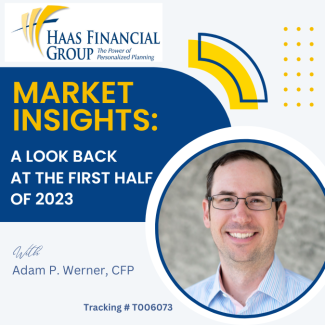
Market Insights: A Look Back at the First Half of 2023
The first half of 2023 has been an eventful time for global investment markets, highlighted by economic and geopolitical challenges that stirred uncertainty and concern among investors. Despite these obstacles, the market displayed remarkable resilience, successfully scaling the "wall of worry." We will summarize the key highlights and risks observed during the first half of the year and offer insights into the current state of investment allocations.
Navigating the Concerns: Inflation, Fed Rate Hikes, Bank Failures, Debt Ceiling, Geopolitics:
The year's first six months presented a range of concerns; Rising inflation, the prospect of further Fed rate hikes, bank failures, debt ceiling issues, and geopolitical tensions were among the pressing matters. Surprisingly, the Volatility Index (VIX) remained relatively low, signaling a degree of calm in the market, comparable to pre-COVID levels.
Market Breadth and Concentration:
As of June 1st, 2023, the S&P 500 index exhibited significant concentration, with the five largest companies accounting for nearly a quarter of the index. Additionally, the performance gap between the S&P 500 index and the equal weight index widened during this period. However, by June 29th, 2023, both indexes showed positive growth, indicating a potential shift in market dynamics.
Sector Performance, Limited Participation:
Certain sectors, such as Technology, Communications, and Consumer Discretionary, demonstrated positive performance during this period. However, these gains were not uniform across all sectors, as evidenced by the negative performance of the S&P 500 Equal Weighted Index (SPED) at the beginning of the year. The lack of broad market participation raised concerns about the overall strength of the markets, though there have been recent signs of gains spreading to a wider range of stocks, which is a positive development.
Stabilizing Bonds and the Fed's Next Moves:
Bond markets experienced a period of stability, with several bond market sectors generating positive returns. The Federal Reserve hinted at a possible end to its current policy stance, and while there was a temporary "pause" in June, the Fed anticipated further rate hikes totaling 0.50% for the remainder of the year.
Eurozone Recession and Global Implications:
The Eurozone encountered a technical recession due to Q1 GDP revisions. Surprisingly, the MSCI Europe Index remained relatively unaffected, suggesting that the global market might not be severely impacted even if the US were to face a similar recession or economic slowdown later in the year.
Risks on the Horizon:
Several risks demand close attention moving forward, especially potential stress in the banking system. Additional bank failures could exert significant pressure on the Federal Reserve, Treasury, and the government as a whole. In such a scenario, the Fed might be compelled to halt rate hikes or even cut rates, leaving the market vulnerable to higher inflation and a potential rapid downturn. A deeper economic recession or prolonged growth slowdown would most likely negatively impact stocks and future earnings.
Opportunities and Asset Allocation Outlook:
Despite the risks, positive factors should be considered. The cyclical parts of the economy have not become overextended, reducing the likelihood of a sudden market downturn. The labor market remains robust, with initial jobless claims trending higher but overall claims remaining steady, indicating a quick reemployment of laid-off workers. Rebalancing portfolios to target allocations, particularly between stocks and bonds, offers flexibility in case of a stock market pullback, with bond yields currently providing attractive returns. This approach should allow bonds to act as effective diversifiers to stock market risk, a role they didn’t play effectively in 2022 amidst rising interest rates.
Final Thoughts: Stay the Course and Prepare for the Future:
Given the current market landscape, it is prudent to maintain a steady course. There is potential for preparing for the next bull market. With consumer spending surpassing pre-pandemic levels and trillions of dollars in money market funds available for deployment into various risk assets during market slowdowns, investors have opportunities to position themselves for future growth. While some volatility may persist, a major downward move is not anticipated at this time.
Conclusion:
The first half of 2023 has presented a series of challenges for the market, including inflation concerns, potential rate hikes, geopolitical tensions, and a technical recession in the Eurozone. Nonetheless, the market has demonstrated resilience, surmounting the "wall of worry." While risks such as banking system stress and economic slowdown persist, opportunities exist, such as rebalancing portfolios and preparing for future market conditions. By staying the course and remaining mindful of potential shifts, investors can navigate market volatility and position themselves for future growth.
Resources:
Investment Advice offered through Great Valley Advisor Group, a Registered Investment Advisor. Great Valley Advisor Group and Haas Financial Group are separate entities. This is not intended to be used as tax or legal advice. Please consult a tax or legal professional for specific information and advice.
Tracking # T006073

